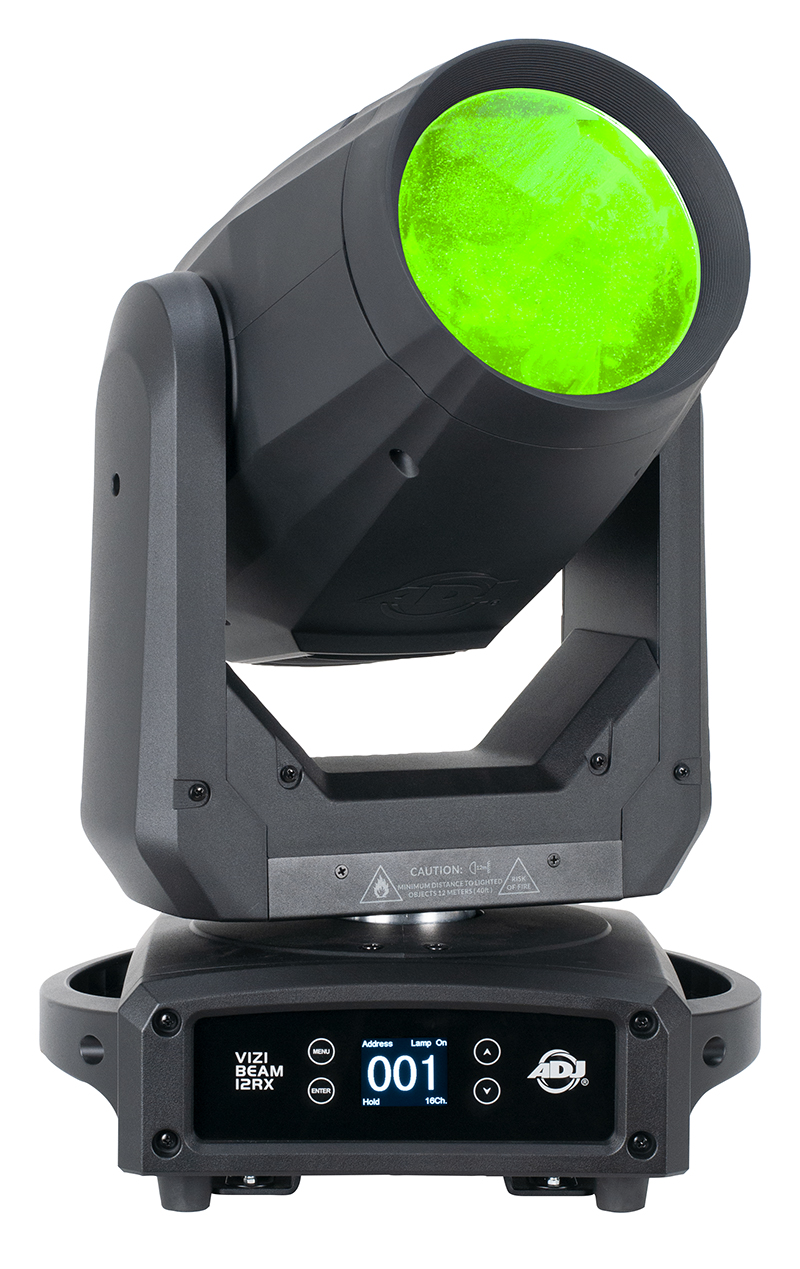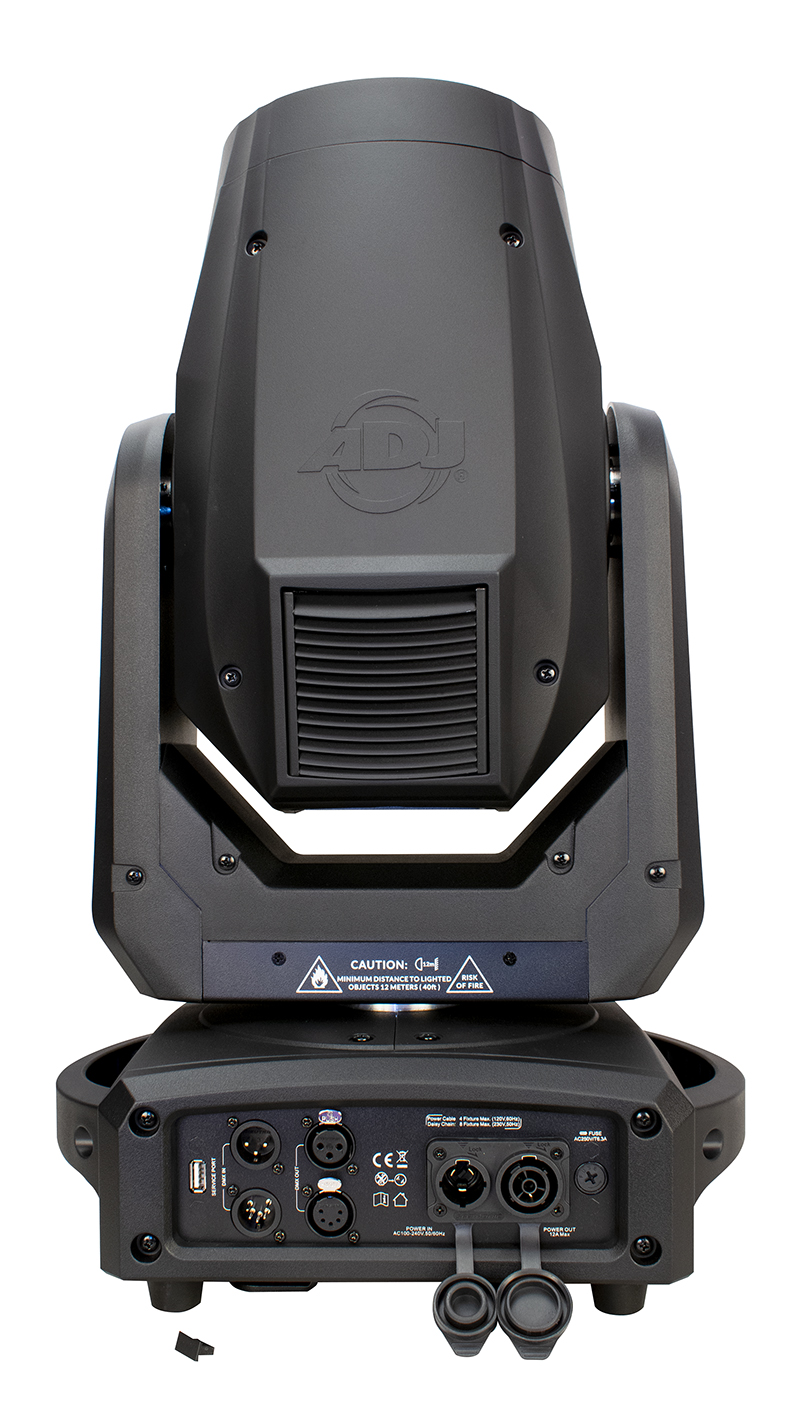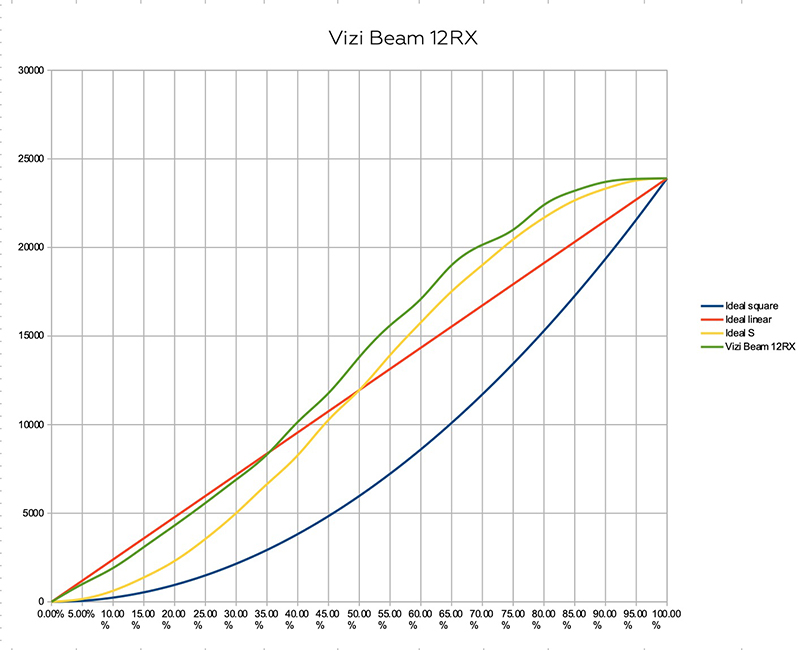
Let us consider the state of the world of entertainment lighting as it pertains to arc lamps, for the change from even just a decade ago has been remarkable. We live with competing modalities of generating the raw lumens for our effects — arc and LED, and not much in between, and of great interest currently is the eventual phasing out of these tiny bottles of lightning in favor of their solid-state brethren. This is all well and good. It must be said, however, that the arc lamp has matured… somewhat. Being threatened with obsolescence must be terribly clarifying, because when manufacturers first started releasing LED fixtures bright enough to matter, we quickly got entertainment arc lamps that were many times more efficacious than their predecessors, lasted longer, and had improved color stability throughout their lives. Short-arc arc lamps still excel in certain types of lighting work, like in the fixture we shall examine today: the Vizi Beam 12RX from ADJ.

Brightest Yet
ADJ claims the Vizi Beam 12RX is their brightest beam light to date, powered by the 260W Philips Platinum 12R lamp. This particular lamp has a rated color temperature of 7,800 Kelvin. That’s quite a cool color temperature, which fits this light’s intended application niche — this is a fixture for blasting beams of light across arenas and stadiums, not lighting faces or scenery. Lamp change is, quite pleasantly, a fast and relatively easy affair: there’s a captive lamp housing door at the rear of the fixture, and the lamp is held in by springs. No fiddly screws falling into the innards of the light when you can least afford it. This long-life lamp from Philips is rated at 6,000 hours, so lamp changes shouldn’t be a particularly frequent occurrence. These ultra-short arc lamps have some demanding cooling requirements, and so in addition to the two large fans providing overall cooling, there is a smaller fan aimed directly at the envelope to keep the lamp within thermal tolerances.
Immediately past the split angled hot mirror are a pair of dimming flags. These are a simple curved design, each with their own separate motor, and also provide the strobing for the unit. I measured 226,000 lux at 5 meters. Tested at night, it projected an impressive shaft of light into the sky in front of my house. Measuring the dimmer law was somewhat more difficult; because the dimmer flags are focused within the beam, there’s a sharp cutoff between light and dark, making the beam into a sort of cat’s eye shape as the fixture dims down. The result is that the center of the beam doesn’t dim at all until the flags cover it. In the air, however, this effect is less noticeable. To attempt to give an idea what the dimming looks like to the eye, I measured the curve with the frost flag in, and the resulting curve is published here, hence the much lower top number on the graph. The curve has some bumpiness in the rage, but that’s to be expected with this class of fixture. All of the expected strobe effects are here, including synchronous strobes, pulses, and a random strobe effect. The beam spread at the lens with nothing else in the beam path is a very tight 2°.

Effects Module
Most of the luminaire’s effects are housed on a single removable module within the fixture. First in line past the lamp is the indexing color wheel, which has 14 colors plus open. Included here are a CTO and CTB filters, which are all trapezoidal filters glued in place. Changes between colors is very fast, and there is very little space between filters. While the color wheel in its indexing range can produce split colors, in practice I found that individual values often did not stop nicely on usable half colors, with either one color or the other dominating. Adjusting the behavior of the fixed color wheel through a software update might remedy this. There’s a good range of saturated and pastel hues here, and several adjacent colors would make for excellent chases or effects.
On the same module is the fixed gobo wheel, which features 16 patterns plus open, with four of these being beam reducers for getting razor-sharp points of light. These are all stamped into a single wheel and can shake.
The patterns on this wheel will all probably look their best when paired with either of the light’s two prisms, which we’ll discuss below. After the gobo and color module are the moving lens elements, two prisms, and the variable frost filter. The frost nicely smooths out the field, turning the output into a nice wash effect for times when you need a soft edge. Prisms consist of a 24-facet circular prism and a linear prism, and these can be overlaid in the output at the same time. The linear prism exhibits a certain amount of center-to-edge falloff, but this is normal for prisms of this type. The 24-facet prism is a real standout: it creates very attractive tunnels of light and is capable of some spectacular effects. Both prisms provide good image separation and can be both indexed or rotated.
There is a motorized focus for sharpening or softening the gobos. One thing to note is, due to the position of both prisms in the optical train, inserting any of these three effects will cause the moving focus elements to move out of the way to make space for them. This overrides the focus function and restricts a small part of the range, something to be aware of in programming. Pan and tilt speed are good, taking 1.2 seconds for a full 270° tilt movement, and 2.1 seconds for a full 540° pan movement, which should be snappy enough to satisfy most users. I noticed no judder or stepping, even on slow moves.
This unit is somewhat friendly in terms of serviceability. The only module that can be removed is the gobo and color module, which involves removing several non-captive screws and is not a process I would attempt while a fixture is in the rig. Fixture functions can be set from the front display, which is a simple LCD panel with four buttons for addressing the light and setting personality functions, and the fixture also has an integrated USB port for software updates.
From a warm start, the unit takes 29 seconds from home to final output, and when reset, waits to output light before reaching its final pan and tilt position. DMX in is via both three and five-pin XLR inputs and pass-thrus, and the fixture supports RDM as well. The unit is 22.25 inches tall with a base that is 10” by 13.8” and weighs in at 42.8 lbs. Rigging is via the extremely familiar Omega-style brackets that attach to the bottom of the fixture with a simple quarter-turn, and power is via Seetronic TRUE1 PowerCON-style inputs and pass-thrus, and the unit auto-ranges from 100V~240V, and draws 384W at 120V, easily able to run off a household circuit.

At a Glance:
A Multi-Functional Contender
The Vizi Hybrid 12RX enters a busy sector of the marketplace, competing against multiple other units that offer multiple functions in a single unit. It’s not “just” a beam fixture — with the inclusion of the two prisms which can be overlaid and the included frost, it can serve up a variety of looks. Whether it finds use in a club or DJ or touring rig, it should be at home anywhere a light that needs to fulfill these roles is needed.
Vizi Beam 12RX
PROS: Compact and light, outstanding prisms
CONS: I wish the color wheel was more smoothly indexable
FEATURES
- Long-life lamp from Philips (6,000 hours)
- Motorized Focus
- 2 DMX modes (14 or 16 channels)
- RDM control option
- 3-pin and 5-pin DMX in/out connections
- IP65 power locking in/out daisy chaining connections
- Color display with 4-button internal menu system
- USB service port for firmware updates
STATS
- Lamp Source: 260W Philips Platinum 12R
- Native Color Temp: 7800° K
- Max Power Consumption: 384W
- Gobos: 16 + open on stamped wheel
- Frost Filter: Slightly variable
- Color System: 14 colors + white on a wheel
- Prisms: 6-facet linear and 24-facet circular. Both rotatable
- Beam Angle: 2°
- Size: 22.25” x 13.5” by 13.8” (HxWxD)
- Weight: 39.7 lbs.
- MSRP: $1,399.99
Manufacturer: ADJ
More Info: www.adj.com


